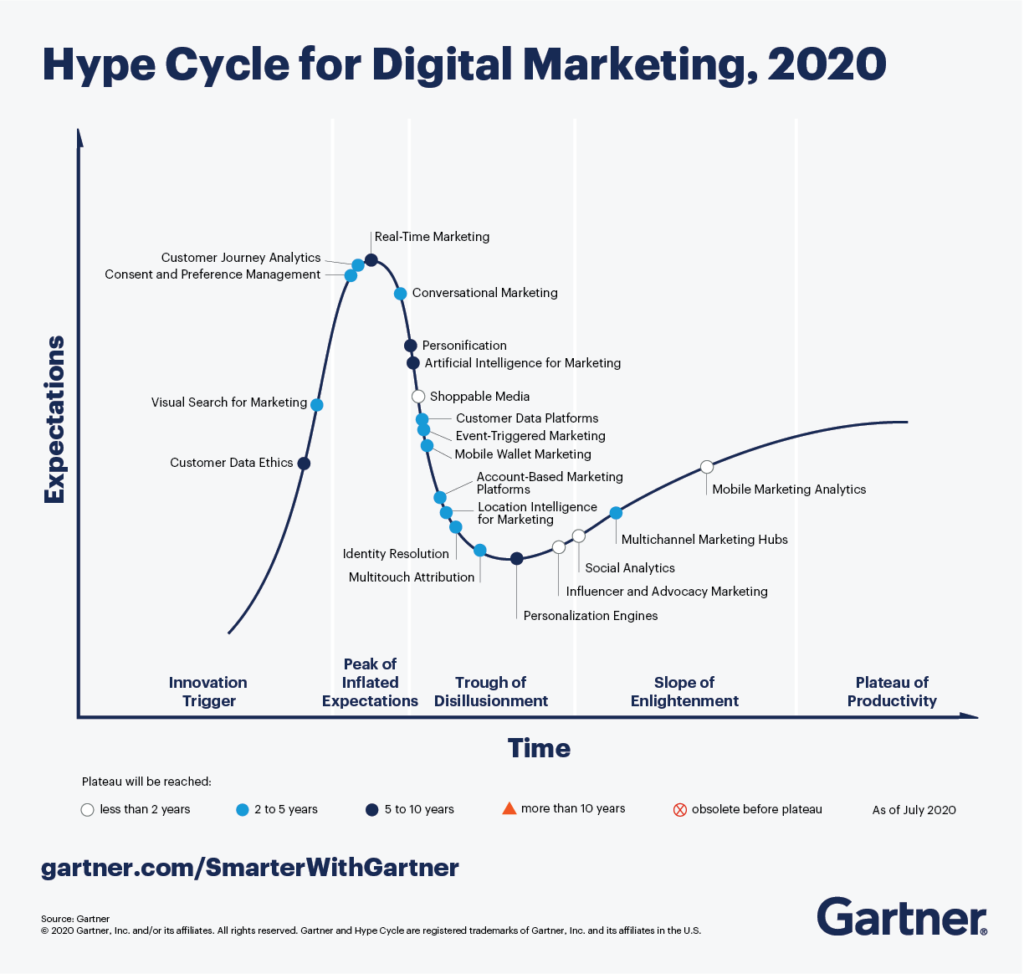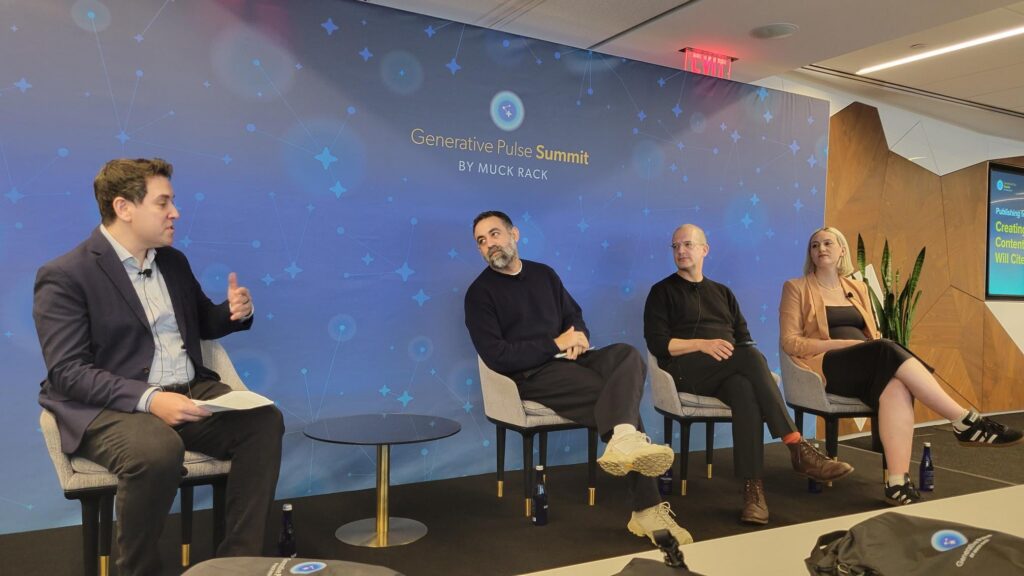Digital marketing—and the technology platforms that enable its success—is having a moment. In the face of the COVID-19 global pandemic, brand marketing teams within a variety of industry verticals are relying on digital technologies to accommodate remote work and drive revenue for business functions. The result is a spotlight on marketing technology investments that facilitate online engagements in the absence of physical world interactions. Enter Gartner’s 2020 Hype Cycle for Digital Marketing, which evaluates categories of technologies at marketers’ disposal and assesses how the industry’s expectations have evolved, from hype to reassessment to disillusionment to maturation. We take a look at the top five technologies that made the Hype Cycle here.
But according to Mike McGuire, vice president analyst in Gartner’s Marketing practice, the key word here is “hype.” He notes that just because a technology moves off of the Hype Cycle and onto, say, the “Plateau of Productivity,” that doesn’t mean that it isn’t important to marketers. Take email marketing, which has been off the Cycle for years. Nonetheless, marketers still invest in email marketing. It has simply reached a state of maturation. There are standards and platform providers offer the capability, McGuire says.
Following is a conversation with McGuire about investment in martech stacks, the technologies that have received the most attention this year, the importance of data ethics and martech innovation in the COVID-19 era.
CHIEF MARKETER: Why is martech innovation so important right now, in this COVID-19 moment?
Mike McGuire: In this particular moment, to a large degree, investments we make in technology [need to] not only fit the bill in terms of what a marketing team needs or wants, but it’s how those technologies are integrated into a martech stack—not just to meet a specific set of functionalities, as important as those are. It’s how my martech stack investment not only allows me to be effective as a marketer in a normal world. That functionality you’re buying you would expect to work. Take a large retailer: Am I also able with this martech platform to enable that retailer to operate in a changing environment, or is my system designed only to work in a perfect world?
For retailers, the first thing they needed back in March was capabilities in their martech stacks with a marketing cloud, with mobile capabilities, to do things like buy online and pick up in store. We don’t browse anymore in physical stores. That was already happening, and now it’s particularly acute. I need to be able to fulfill, to be able to drive demand. So, are my recommendations or personalization capabilities allowing me as a marketer to now give people a better browsing experience online? And does it have the tactical or the logistical capability to take the order online and have enough certainty to have the system spit back a message?
So, when we look at these investments, it’s enabling resilience for the marketers who were using these platforms. They’re having to adjust to their customers and prospects who are operating in a very different and disrupted world. Resilience is one of those key messages we were trying to get across. This also then takes us into that next phase of event triggers and real- time capability. These are all capabilities we’ve been talking about and putting into a martech stacks for years, but this is an environment where those become particularly important.
CM: Why will customer data ethics take 10 years to reach full adoption, and what will influence that?
MM: The topic itself is one that I think a lot of people don’t think about actively. But there’s a couple of things. One is this notion that, increasingly, I have to be compliant with the laws and regulations that govern how I collect and utilize consumer data or customer data. We’ve been able to use things like terms and conditions. What we’ve seen in this research is that people do make certain associations with brands. One of them is brand trust. It’s a thing that we’ve learned in business school and marketing for decades—that a brand is not just functionality. Brand also includes a lot about trust. I “trust” that these running shoes or this guitar I want to buy meets a certain set of specifications because it says it has these capabilities.
[As a consumer] I want to make sure I understand, as part of my trust, that the retailer has enough information about me to satisfy my demand, but that they’re also going to treat that data ethically, not just be compliant with the law. As part of that, I know that they’re not going to sell it off to a third party across any number of other entities. It might be technically allowed because I opted in, but part of that notion of trust is being transparent about how we’re using that data. Now, we’re seeing a lot of that, particularly with the California Consumer Privacy Act that went into effect and the GDPR in Europe. These requirements exist.
What we want to make sure we can start to deliver on is developing not just the technology to be compliant, but the approaches that show a certain amount of empathy and understanding. We’ve done some interesting research on consumer surveys where we ask marketers about some of the key hallmarks or tactics they use to engage them. [They say] “we send lots of emails, and more engagement is better.” When we asked the flipside of that coin to consumers, what they’ll tell you is, I love a lot of brands. I buy regularly from them. On the other hand, my notion of love only extends as far as the next step, the offer that comes to me from another brand. If another competing product shows up when I need it, I’m going to look at that. Consumers now have access to information and they’re not going to be dependent just on you, on your brand, to tell them what they need.
One of the things we look at when we start building trust is this: I have to earn that every single time I engage. And I need to be able to demonstrate that I’m treating the data with a certain ethical approach. It’s not just putting a one-minute video up on our Facebook page or Instagram page saying “we’re here with you,” and so therefore we have empathy. Don’t just tell me, show me.
CM: Why do you feel like AI has been such a challenge for marketers to master as a tool?
MM: So much of our marketing now can be automated. But if we take just what the AI says and it’s the most expeditious way to solve this problem, and not provide some sort of a boundary around that, we start raising some pretty interesting risks. AI is extraordinarily complex. It’s a combination of technologies that are used that aren’t easily observed. It’s a black box; you put the data in and it comes back out and [we have] no idea how we got there. Whereas if we were using some of our conventional tools, you can take these datasets and put these constraints or requirements around it and that spits out a segment that I can use to market for a campaign.
AI can discover patterns that a human with a good computer might have intuitively gotten to but it would have taken too much time. These systems can generate and process so much data so quickly that they could start to identify patterns. And if you change your messaging, now you’ve opened up a new segment that you thought wasn’t interested in your product or service.
Part of this is a level of trust. Marketers have to get comfortable with what these systems are generating… where they understand and trust that that result is something that they can actually work with. More importantly, back to the ethics issue, is this result going to be a moral and ethical decision to target these users this way? What were the datasets that were used to come to this potential of capability with this particular outcome? We can’t just rely on what the system spits out. Human oversight is particularly important. It’s a thing that’s assisting you with your massive amounts of data and identifying what you might’ve gotten to it a few years. But use this tool in that fashion to help you discover, to understand.
CM: Talk about location data’s potential for marketing and what’s hampering it.
MM: There’s a number of ways that it’s particularly useful. One of the challenges is this notion people have with location intelligence or location-based capability in real time. But you need a pretty good understanding of that set of users or those individual users you’re targeting. An old colleague described the balance point: proximity does not equal permission. Many consumers will keep location tracking off of their applications because they don’t want to be pestered.
The last set of surveys we did a couple of months ago indicated that consumers will allow their location to be tracked primarily in a couple of use cases. One: I want to find a store that has a service provider nearest me. The other one is, I’m willing to have my location shared if that product or service provided needs to deliver something to my location. We’re seeing people keeping location tracking on only when using that application.
One of the challenges marketers need to understand is what level of location information is going to be the most effective—and at the same time, under the customer’s desire, not to be tracked 24 hours a day. Location intelligence is not just about our ability to gather the data. The technology will do that; apps will do that. What’s the value exchange to the consumer? The potential benefits of location tracking over time should be more focused on what that tells us about an individual—not exactly where they went.
CM: Does anything about the rankings of different technologies surprise you? What’s the most interesting?
MM: In terms of progression, some of the interesting shifts that I see here is that customer data platforms are moving down towards the Trough of Disillusionment. But I would caution readers not to take that as that it’s never going to come out. We point out that any technology passes through these phases. It may spend some more time in the Trough of Disillusionment because sometimes there is some confusion or questions marketers have about where it fits in my stack and if it is a separate thing or something they should increasingly look for their marketing system of record to provide. In the marketplace now, more and more [CDPs] are becoming a feature or capability that’s built into a larger platform like a multichannel hub. That’s one of the reasons we’re seeing it pass through into the Trough. It’s not that it’s bad technology.
What’s out there for the first year is customer data ethics. A lot of marketers think about that, but perhaps not day-to-day, and not thinking about it as an element of their brand promise and brand value.
When we look at up “The Slope of Enlightenment,” event-triggered marketing is increasingly in a more prominent place. That used to be something that was tougher to manage or integrate into our systems. It’s now becoming a more automated process where I can understand that you’re at the end of a subscription period, at the end of a warranty or it’s your anniversary of becoming a customer. Or you hit a certain phase on the website in a buying journey and you’re hanging up. I need to be able to message you, to diagnose why you’re hanging up on that purchase journey and then be able to send you a push notification. It’s maturing pretty quickly.
The other one that’s going to be interesting, which is heading into the Trough now, is identity resolution and multi-touch attribution. They are two that marketers need to keep an eye on. Identity resolutions are crucial. It’s going to get harder, though, because we’re seeing browsers and applications, particularly iOS applications, deprecating third-party trackers. So, for a lot of companies, attribution could get harder as we move forward. As Google has said, they’re going to deprecate third-party tracking. Unless the user has multiple affirmative steps to allow it, it’s off. You can’t try to shoehorn that in without getting very specific opt-ins for the consumer. That’s going to be a challenge for brands. How many locations, and how are you tracking with the app? It becomes an important thing as we try to figure out our attribution strategy and which parts of this journey need to be credited for guiding that conversion.






